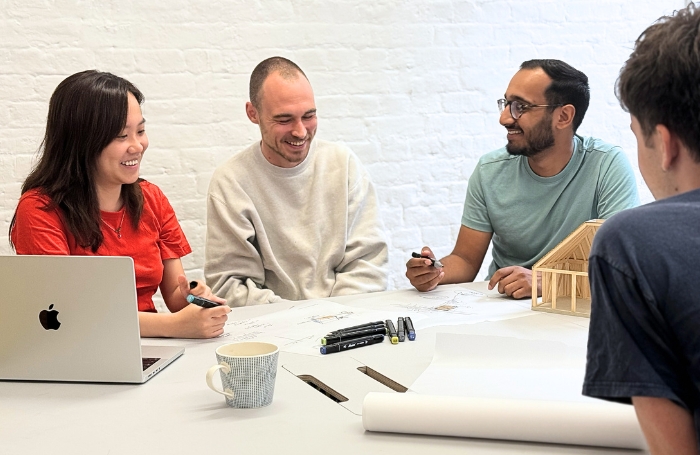Architects are often encouraged to specialise in particular disciplines in sectors such as residential, healthcare, or commercial, with the promise of reputational benefits, deeper expertise, and greater precision. However, when market conditions shift and sector-specific opportunities fluctuate, practices may find themselves advised to diversify their portfolios.
Striking a balance between sector expertise and the agility to pivot into new typologies can not only futureproof a practice but also unlock fresh creativity and innovation. But how does a practice begin to diversify?
London-based , now approaching its tenth anniversary, managed to work across multiple sectors from the outset. Co-founding Director, Al Scott, explains that the practice achieved this by promoting how they work, rather than what they work on. From day one, it was determined not to be pigeonholed.
At November’s event for small and medium-sized practices, Al will share how IF_DO set out to be specialists in a design approach rather than a typology, and built an enviable spread of work along the way.

How did IF_DO achieve diversification?
- subtitled The DNA of Practice - examines how architects can create a meaningful brand, promote specialisms, and express their values in ways that resonate with clients, collaborators, and communities.
To many small practice start-ups, IF_DO’s early development might seem like a bold rejection of sector-based specialism. When Al, Sarah Castle and Thomas Bryans co-founded the practice, they had little more than a manifesto. Its key guiding principle starts with the practice name itself: IF_DO. The name, Al says, embodies the practice’s approach: “IF” represents a questioning, research-focused mindset, while “DO” demonstrates the drive to create physical spaces that make a genuine difference. This approach is used on all projects.
Before securing any projects - or income - they hired branding, marketing, and PR consultants, believing that cementing the practice's visual identity, logo and key guiding principles was key to building a diverse portfolio and demonstrating a different way of working.
This brand-first approach was a huge, scary, leap of faith, Al says, especially because they were yet to do any billable work.
Another key decision taken early in its existence was to maintain a balanced portfolio on its website – orchestrating content to show only what they wanted more of. Although early work was predominantly residential (around 80%), the practice chose to keep a manifesto holding page live rather than showcasing majority residential projects. “We made a promise to ourselves that we would not put more than 20% of our residential [work] on the website, or maybe a third maximum,” Al says. “If we had three residential projects that we were really proud of, we would only allow ourselves to put up one, until we had balanced it with other work (built or theoretical).”
This deliberate curation forced the practice to vary its portfolio, ensuring visitors never left the site thinking they only worked in one area. While IF_DO does enjoy residential work, it was crucial to communicate that it also does much more.

What were the benefits of its brand-first approach received?
There were concerns that this uncompromising approach might alienate residential clients, especially in the early days when they were essential for turnover. But it didn’t. Instead, it helped attract the kinds of clients IF_DO truly wanted to work with. The manifesto became a key tool in engaging with commercial and community clients who saw the practice as different.
Now, 10 years on, IF_DO is undergoing a rebranding exercise, which presents an opportunity to reflect on the brand and practice principles that have served them so well. Its website now showcases work across arts, commercial, community, education, heritage, temporary “meanwhile” projects, and residential sectors.
For all this time, the practice’s original manifesto has remained its constant guiding light, its North Star, as Al puts it. It’s a statement of intent that resonated with clients. Those who didn’t connect with it simply went elsewhere.
The practice continues to work closely with communities on social infrastructure projects and has published materials on its co-working and co-design processes, including booklets for community clients. This collaborative ethos still runs through everything it does.
It’s a textbook example of how a branding exercise should work, though rarely does. Mission statements often fade, but IF_DO has kept its relevant by embodying it in its logo, and practising it. IF_DO’s journey has been anything but typical, using a brand-first approach to demonstrate an ethos that can be applied to different sectors.
“Architects are frequently asked to justify their ability to work in any new sector outside private residential, which is strange really when our education focuses on pretty much everything but residential” he says “This leads many feeling pigeon-holed, and pivoting the practice into a new area can requires a lot of energy, so far better to be agile, and demonstrate that you’ve got that ability to start with.”
Thanks to Al Scott, IF_DO
Text by Neal Morris and Paul Hirons. This is a Professional Feature edited by the RIBA Practice team. Send us your feedback and ideas.
RIBA Core Curriculum topic: Business, clients, and services.
As part of the flexible RIBA CPD programme, professional features count as microlearning. See further information on the updated RIBA CPD core curriculum and on fulfilling your CPD requirements as a RIBA Chartered Member.



